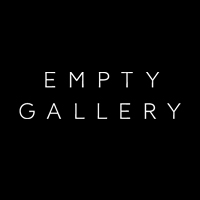“After Ruins” at Nonfrasa Gallery
By Emma O'Neill

Installation view of "After Ruins" at Nonfrasa Gallery, Bali, 2025. Photo by Kadek Bagaskarra and Ganesa Putra. Courtesy the artists and Nonfrasa Gallery.
After Ruins
Nonfrasa Gallery
Bali
Feb 22–Apr 22, 2025
Today, to remember is to look at a photograph. Amid the impulse to capture “the moment” and technology’s interruptive prompts for nostalgia, photos have become proof of truth even when accompanying recollections have long since evaporated. For Krisna Sudharma—founder and artistic director of Bali-based contemporary art gallery Nonfrasa—our modern-day approach to memory calls into question: “Are we truly living in the present, or are we caught between dreams of the future and the fragmented remnants of the past?” At Nonfrasa, “After Ruins” probed the act of remembering, and art as its alternative archaeology. The group exhibition revealed dialogues between past and present by local makers and artists from the DESA residency program.
Nonfrasa is housed in an airy Joglo-style building with a high pyramid-shaped roof. The sparse interior embodies the qualities that Sudharma has gravitated toward since the gallery’s 2021 inception: rawness, openness to transformation, and fidelity to local tradition. Outside the gallery’s glass backdoors, vines tangle at the base of the once-lurid purple, orange, and green brick walls that make up Australian artist Andrew Liversidge’s installation, ALL THAT FALL (orange green purple) (2023), which was—in a 30-minute performance—sledgehammered by its maker and left to deteriorate over time at the mercy of the tropics. Created on residency at DESA, the work is a permanent yet ever-evolving fixture of the gallery, serving as a monument to durational decay as well as the generative friendship between neighbors: Sudharma and the residency’s founders—artists Todd McMillan and Sarah Mosca.
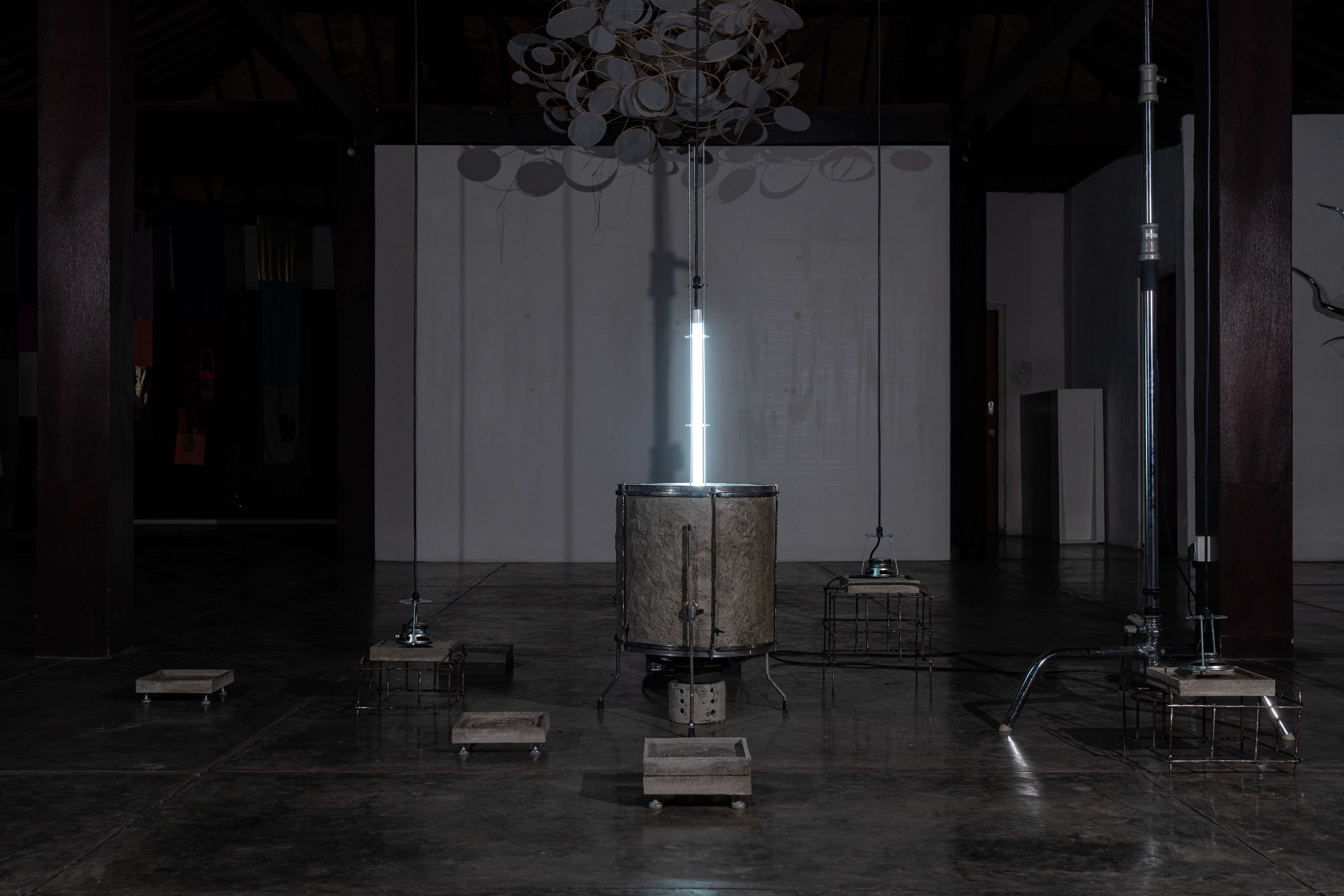
Installation view of PANDE WARDINA and PUTU SEPTA’s Cakra Ning Kala, 2025, steel, cement, acrylic, wood, and speaker system, dimensions variable, at Nonfrasa Gallery, Bali, 2025. Photo by Kadek Bagaskarra and Ganesa Putra. Courtesy the artists and Nonfrasa Gallery.
Within the gallery, a large-scale installation entitled Cakra Ning Kala (2025) was placed at the center of the room—a collaboration between visual artist Pande Wardina and composer Putu Septa, who both draw upon their Balinese heritage. Featuring an illuminated neon obelisk dangling within a drum, the work was surrounded by small square cement and wooden objects raised on delicate steel scaffolding, each representing the work’s accompanying sound, composed by Septa. Drawing from a rich lineage of Balinese Gamelan musicians, Septa’s practice is grounded in the techniques of the traditional ensemble music—specific tuning with percussive, rhythmic, and metric patterns—while merging it with new modes of production. In the gallery, frenetic looping of Gamelan phrases thickened the exhibition’s atmosphere, as though propelling the audience through space and time via a genre that remains central to traditional local ceremonies.
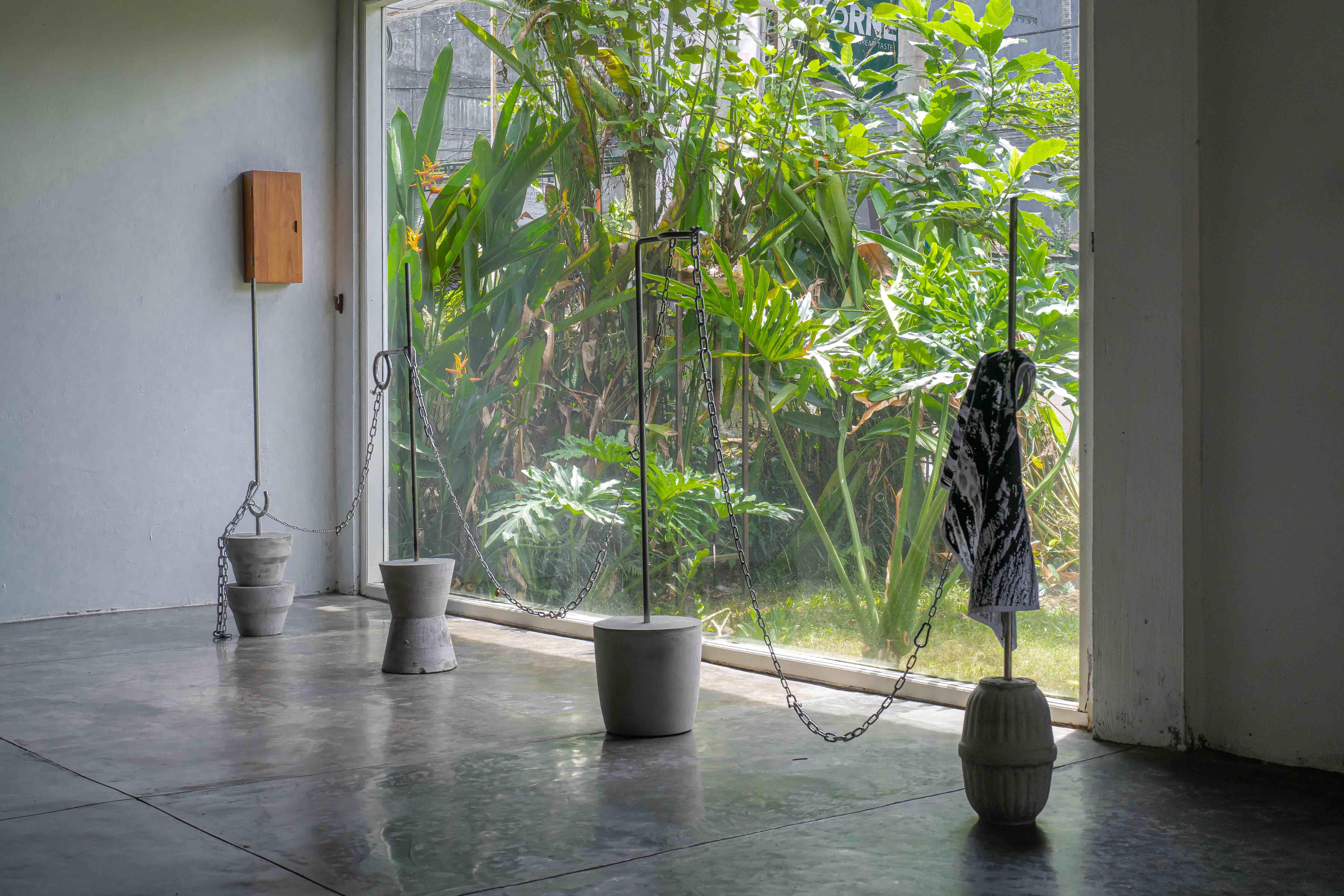
Installation view of JEN BEREAN and JAMES CAREY’s Loose Footings, 2025, concrete, steel, brass, acrylic screen print on organic cotton, dimensions variable, at Nonfrasa Gallery, Bali, 2025. Photo by Kadek Bagaskarra and Ganesa Putra. Courtesy the artists and Nonfrasa Gallery.
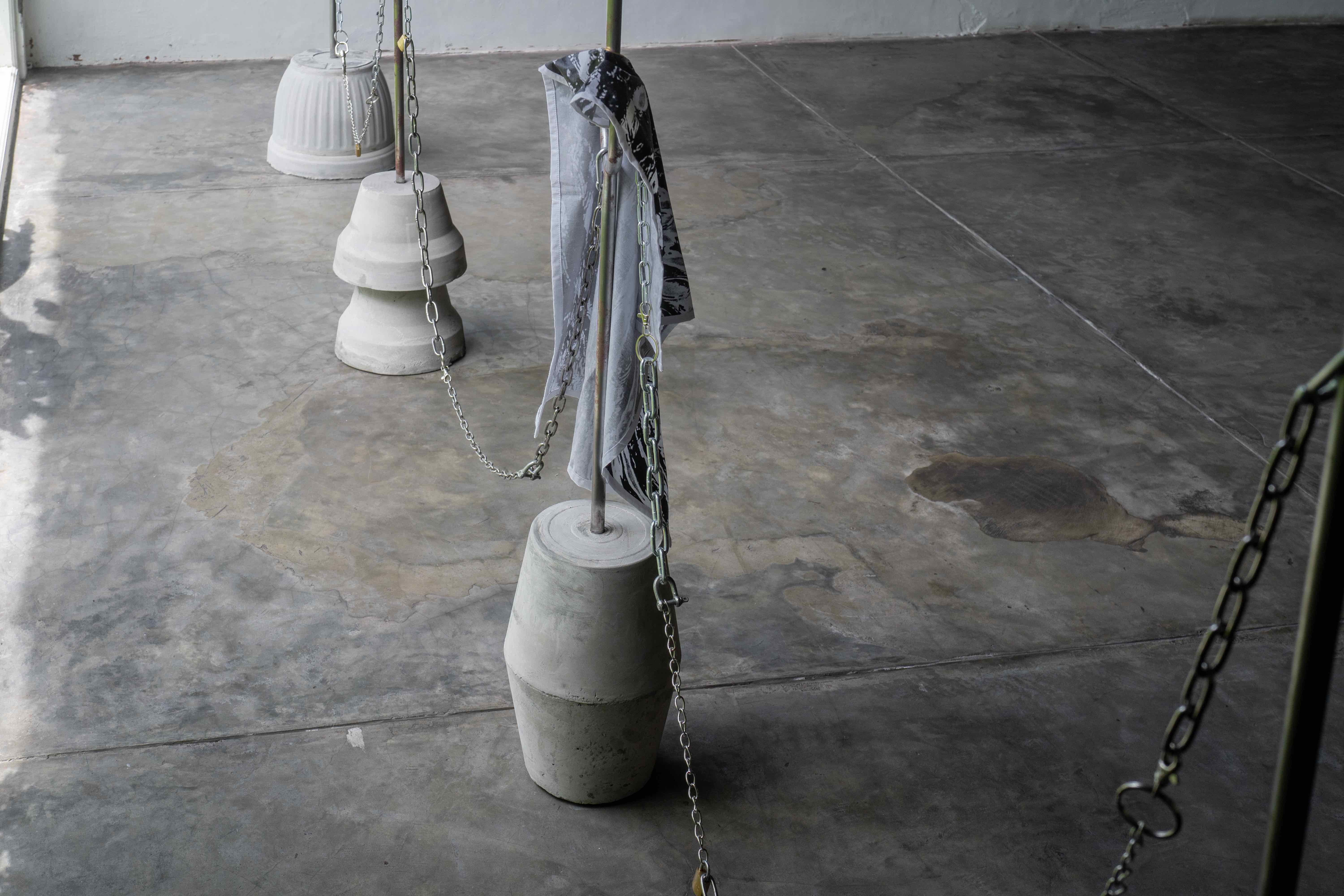
Detail view of JEN BEREAN and JAMES CAREY’s Loose Footings, 2025, concrete, steel, brass, acrylic screen print on organic cotton, dimensions variable. Photo by Kadek Bagaskarra and Ganesa Putra. Courtesy the artists and Nonfrasa Gallery, Bali.
Melbourne-based artists Jen Berean and James Carey’s Loose Footings (2025) comprises concrete and steel bollards connected by single strands of slouching chains—industrial materials tempered by the adornment of a screen-printed black-and-white cotton flag. Set against the gallery’s front windows, objects used throughout the island to facilitate or impede movement become cursory—there is nowhere to go but the present moment.
Overhead, the dizzying twirl of bamboo, rattan, and white nylon paper of Heavenly Snow Ice (2024)—by Bali-born sculptor Kadek Armika—contemporizes the long-held Balinese tradition of kite-making. The curious chandelier was suspended from the windless confines of the thatched gallery roof, while white lunar shapes of various sizes seemed to be spinning; bamboo curling—the arc of time curving.
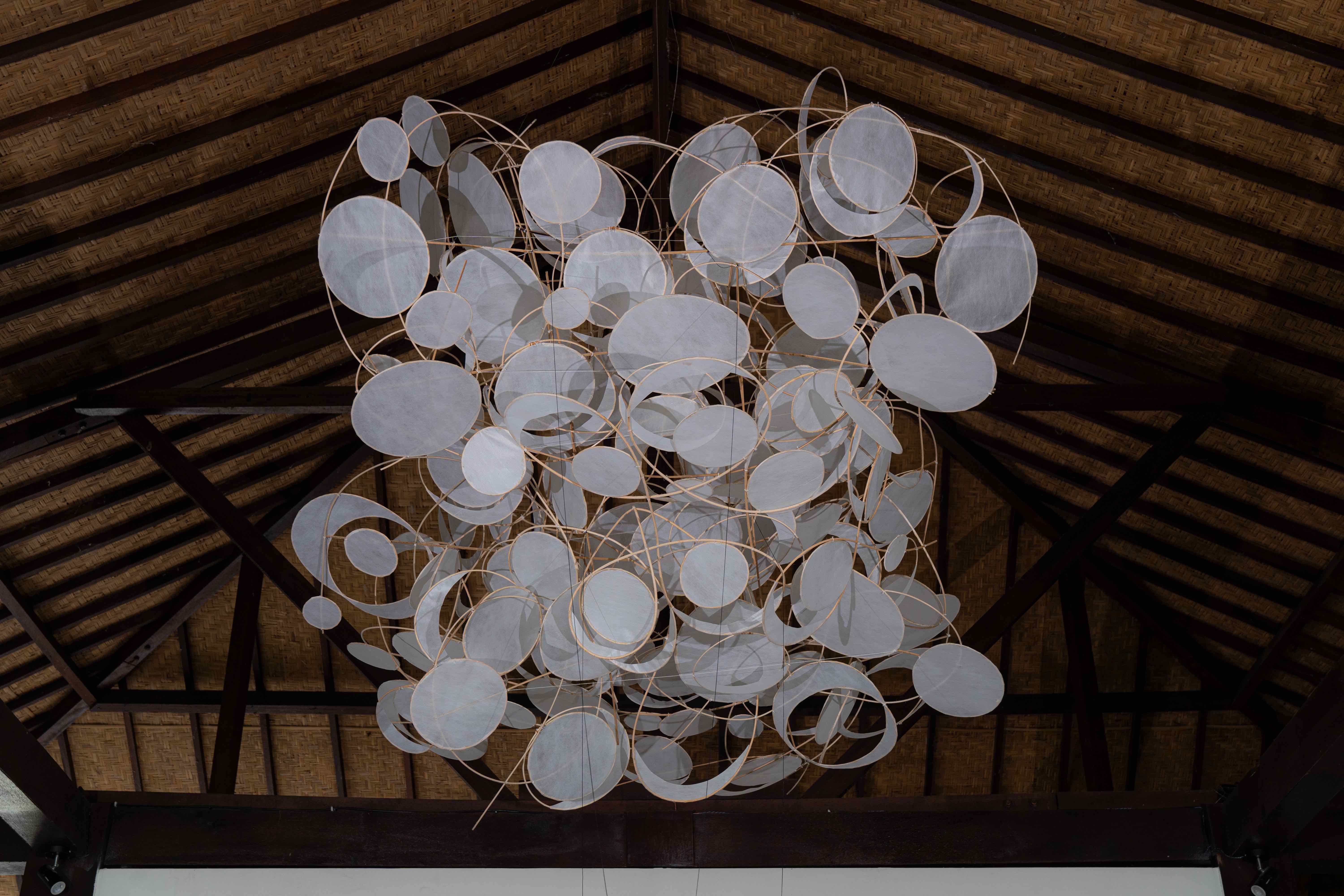
KADEK ARMIKA, Heavenly Snow Ice, 2024, bamboo, rattan, and nylon paper, dimensions variable, at Nonfrasa Gallery, Bali, 2025. Photo by Kadek Bagaskarra and Ganesa Putra. Courtesy the artists and Nonfrasa Gallery.
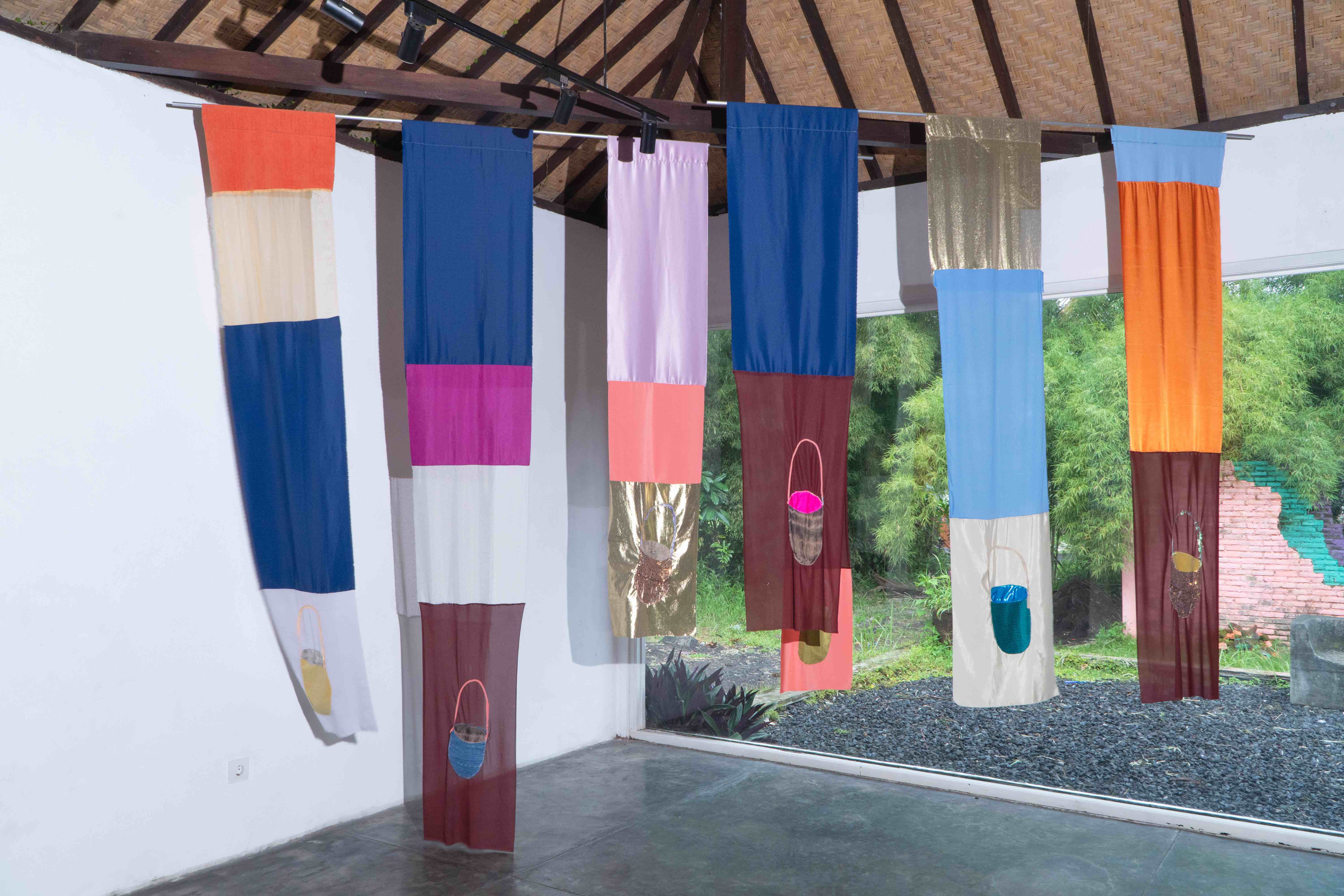
KATIE WEST, Sunrise after Sunrise, Sunset after Sunset, 2024, hand dyed cotton, organza, lycra, thread, sequins and ANDREW LIVERSIDGE ALL THAT FALL (orange green purple), 2023, wall paint on bricks, 700 × 230 × 500 cm,at Nonfrasa Gallery, Bali, 2025. Photo by Kadek Bagaskarra and Ganesa Putra. Courtesy the artists and Nonfrasa Gallery.
Nearby, Yindjibarndi artist Katie West’s Sunrise after Sunrise, Sunset after Sunset (2024) is crafted from found fabrics in gold, satiny blues, burgundy, peach, and lustrous white, forming banners that honor her familial legacy. Using materials like organza, sequins, lycra, and velvet, each piece is patchworked with images of the dilly bags woven by her ancestors. Weightless yet stitched with embodied knowledge, West reconsiders how her past has been carried from past to present. While the work’s hues are brighter than the faded colors of the Liversidge’s courtyard sculpture, both coalesce in their shared reverence for history—ancestral, artistic, personal—and the inevitability of change.
In this space, materials offered an alternative to the usual methods of making memories, both individual and collective, while attempting to reach forward into the future. In this way, “After Ruins” proposed art as a more embodied and nuanced means of reflecting on the past.
Emma O'Neill is a writer, curator, and arts manager based in Sydney.





